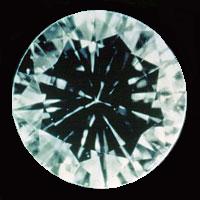Diamond Cut for Weight refers to the practice of adjusting a diamond’s proportions to maximise its weight, sometimes at the expense of optimal cut quality. This process is typically seen when a diamond is cut to a specific carat weight, and the diamond’s proportions are altered to retain as much weight as possible from the original rough diamond. While it’s important to understand that this does not necessarily mean the diamond is cut poorly, the cut for weight can affect the diamond’s overall brilliance, sparkle, and light performance.
How Cut for Weight Affects a Diamond:
Weight Preservation:
Diamond cutters aim to preserve as much weight as possible from the original rough diamond. In some cases, this means making the diamond deeper or shallower than ideal to keep the carat weight intact.
A diamond that is cut to maximise weight may have proportions that are not ideal for light reflection, leading to less brilliance compared to a diamond cut to ideal proportions.
Depth vs. Table Size:
Shallow cuts (where the diamond is cut too wide with less depth) or deep cuts (where the diamond is cut very deep with a small table) are common in diamonds that are cut for weight.
Shallow-cut diamonds tend to have a larger table size, making them appear larger face-up, but they often lack brilliance since light escapes from the bottom rather than being reflected within the diamond.
Deep-cut diamonds may appear smaller for their weight because the table appears smaller, but they can reflect less light, leading to a less vibrant appearance.
Cut for Weight and Diamond Shape:
When cutting diamonds for weight, it is common to see a variety of shapes, including round and princess cuts, but some shapes are more prone to cut for weight than others.
For example, round brilliant diamonds are often cut for weight in ways that sacrifice the ideal proportions, leading to either a shallow or deep cut. Similarly, emerald cuts and asscher cuts may also be cut for weight, leading to larger faces with less depth.
Trade-offs Between Weight and Quality:
Cutting for weight can be a trade-off between achieving a desired carat weight and ensuring the diamond has optimal proportions to maximise its brilliance.
A well-cut diamond with excellent proportions will typically have the best brilliance and sparkle, but it may not be as large as a diamond that has been cut to maximise weight.
Light Reflection and Brilliance:
The cut quality of a diamond is directly linked to how well it reflects light. Ideal cut diamonds are designed to reflect as much light as possible, creating that sought-after brilliance and sparkle.
Diamonds cut for weight often have a lower cut grade because the proportions are not ideal for light performance, which can lead to a duller appearance.
Carat Weight vs. Appearance:
While diamonds cut for weight may appear larger due to the size of the table or girdle, they may not look as brilliant or sparkly as diamonds with ideal cuts. The key consideration is whether a larger diamond, cut for weight, is worth more to the buyer than one that is smaller but has superior light performance.
Choosing Between Weight and Quality:
Many buyers prefer diamonds that are cut to ideal proportions (even if they are slightly smaller in carat weight), as these diamonds offer superior brilliance and visual appeal.
If a buyer is looking for a specific carat weight, the trade-off may involve a less-than-ideal cut for weight.
The Importance of Cut Over Carat Weight:
When choosing a diamond, the cut often takes precedence over the carat weight in determining the overall beauty and value of the stone. A well-cut diamond, even if slightly smaller in weight, will typically appear more brilliant and attractive than a larger diamond with suboptimal proportions.
Diamonds that are cut for weight might appear larger or offer a higher carat weight, but their light performance and sparkle may be compromised.
How DCLA Evaluates Cut for Weight:
DCLA (Diamond Certification Laboratory of Australia) evaluates diamonds based on their cut quality rather than just focusing on weight. A DCLA report will provide precise details on the diamond’s proportions, symmetry, and polish, allowing buyers to understand the impact of weight-cutting decisions on the diamond’s appearance.
DCLA grades diamonds on cut based on a full spectrum of light performance analysis, including brilliance, fire, and scintillation. This is important because diamonds cut for weight may appear less brilliant, even if they weigh more.
Key Takeaways for Buyers:
Carat weight does not necessarily equate to a more beautiful diamond if the cut is compromised.
Diamonds cut for weight may have shallow or deep proportions that diminish brilliance.
It is generally better to prioritise a well-cut diamond with ideal proportions over a diamond that has been cut to maximize weight.
Always request a DCLA grading report to ensure that you understand the full cut quality, even when prioritising weight.
If you’re considering a diamond, it’s crucial to balance weight preferences with an understanding of the diamond’s cut quality and how it affects the diamond’s overall appearance. Would you like further guidance on understanding diamond proportions and how to select the best-cut diamond for your needs?

